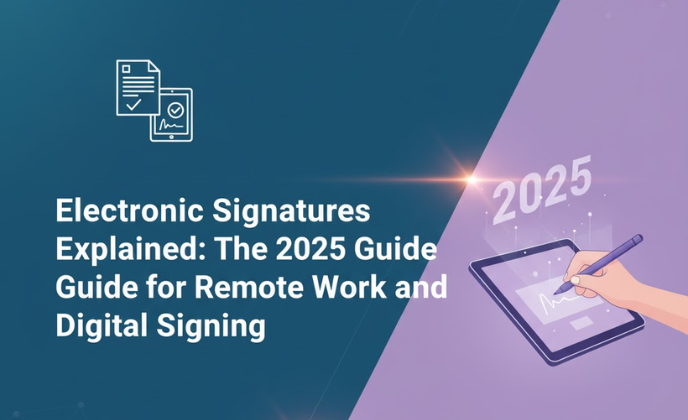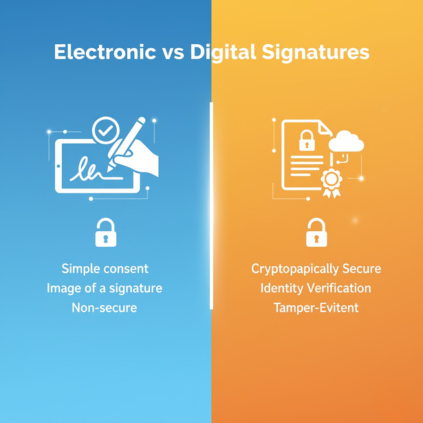Electronic Signatures Explained: The 2025 Guide for Remote Work and Digital Signing

Digital transformation isn’t just about shiny apps, it’s also about taking the most fundamental, paper-based processes online. At the center of this change is the electronic signature, a tool that enables people to sign legally binding agreements from anywhere in the world. With remote work now a permanent fixture, global data-sharing rules evolving, and digital identity on the horizon, electronic signatures are moving from a convenience to a strategic necessity.
This guide is designed for U.S. startups and enterprises that want to understand the electronic signature landscape. It explains what makes an electronic signature legally binding, the different levels of assurance, how remote work is accelerating adoption, and the security architecture that ensures signed documents remain trustworthy. We also look ahead to emerging trends like Europe’s new digital identity wallet and offer tips to successfully implement e-signature technology.
What Is an Electronic Signature?
An electronic signature (often shortened to e-signature) refers to any electronic process that indicates acceptance of an agreement or record. Clicking an “I accept” button, typing your name at the end of an email, drawing your signature on a touchscreen, or using a certificate-based digital signature all fall under this umbrella. The U.S. Electronic Signatures in Global and National Commerce (ESIGN) Act defines an e-signature as “an electronic sound, symbol, or process, attached to or logically associated with a contract or record and executed or adopted by a person with the intent to sign.” The key elements in this definition are:
- Intent – the signer must intend to sign.
- Consent – both parties must agree to conduct business electronically.
- Association – the signature must be linked to the specific document.
- Record retention – a record of the signing process must be kept for future reference.
In practice, electronic signatures can vary from simple typed names to highly secure, cryptographically sealed digital signatures. And while they all share the advantage of facilitating a legally enforceable agreement without a physical piece of paper, they are definitely not created equal – we’ll talk more about that, soon.
Electronic vs Digital Signatures

Although many people use the terms interchangeably, a digital signature is a type of electronic signature that includes the use of public key infrastructure (PKI). PKI involves secure encryption of data using a pair of cryptographic public and private keys, and trusted certificate authorities grant digital certificates to validate the public key. PKI provides a foundation for digital trust to securely encrypt, authenticate, and digitally sign data, devices, and identities. The digital certificate registers the public key to the person or organization, verifying that the sender of the message or signer of the document is actually who they claim to be. A properly implemented digital signature provides:
- Authenticity – the certificate confirms the document was signed by the holder of the private key.
- Integrity – any alteration to the document after signing invalidates the signature.
- Non-repudiation – the signer cannot deny their involvement because the signature is tied to their cryptographic identity.
In the European Union, digital signatures are codified under the eIDAS regulation, which distinguishes between simple, advanced, and qualified electronic signatures.
Legal Frameworks: ESIGN, UETA, and eIDAS 2.0
United States: ESIGN and UETA
The U.S. embraced electronic signatures early. The ESIGN Act became law on June 30, 2000, giving electronic signatures the same legal effect as ink signatures and ensuring that electronic records couldn’t be denied validity simply because they are digital. The Uniform Electronic Transactions Act (UETA), adopted by most states, complements ESIGN by defining how electronic records and signatures can be used in state-level transactions. Both laws require the conditions listed above (intent, consent, association, and retention) to make e-signatures enforceable.
These frameworks have stood the test of time.ESIGN and UETA have demonstrated their resiliency and adaptability, allowing newer technologies like blockchain and artificial intelligence to be incorporated into electronic signing without the need to change the law. COVID-19 put a spotlight on their necessity; by 2020, organizations needed to urgently execute contracts virtually, and e-signature platforms provided the business continuity to keep things moving.
Europe: eIDAS and the Update in 2024 and 2025
The EU has operated under the eIDAS (Electronic Identification, Authentication and Trust Services) Regulation, which went into effect in 2016. eIDAS includes three levels of e-signature:
Simple Electronic Signature (SES) – a nominal signature method like typing your name or checking a box. It is suitable for low-risk transactions but doesn’t authenticate the signer.
2.1. Advanced Electronic Signature (AES) – must be uniquely linked to the signer, capable of being used to verify their identity, created by the signer and under the sole control of the signer, and linked to the signed data in such a way that any change in the signed data at any point invalidates the electronic signature. AESs often incorporate the use of digital certificates and multifactor authentication.
2. Qualified Electronic Signature (QES) – an AES that is created using a qualified signature creation device, and a certificate issued by a qualified trust service provider. A QES has the same legal effect as a handwritten signature in all EU member states, in accordance with eIDAS.
Recognizing a need for cross-border digital identity, the EU adopted eIDAS 2.0 (also referred to as the European Digital Identity Regulation) in 2024, which requires every EU member state to provide its citizens and businesses with a European Digital Identity Wallet by 2026. EDI Wallets will connect national electronic IDs with additional credentials (g., driver’s license, diploma, bank account) and provide a means for individuals to store and selectively share their personal data. Service providers must accept the wallet for authentication, and the regulation emphasizes three features: security (aligning with GDPR and enabling public bodies to issue electronic certificates), convenience (allowing easy access to jobs or public services), and interoperability across Europe. eIDAS 2.0 also introduces new qualified trust services—electronic archiving, electronic ledgers (blockchain), and remote management of signature devices—and broadens the obligations for trust service providers to adopt robust PKI and hardware security modules.
Types of Electronic Signatures and Trust Levels
Understanding the differences between SES, AES, and QES helps businesses choose the right tool for each transaction:
| Simple Electronic Signature (SES) | Basic e-signature methods like scanned images, typed names or ticking an “I agree” box. No verification of the signer’s identity. | Low-risk agreements, NDAs, purchase orders, and internal HR forms. |
| Advanced Electronic Signature (AES) | Requires unique linkage to the signer, identity verification, and cryptographic protection to ensure the signature is tied to the document and any changes are detected. Often involves two-factor authentication and digital certificates. | Higher-value contracts, regulated industries (healthcare, finance), vendor agreements. |
| Qualified Electronic Signature (QES) | Uses a qualified certificate issued by a government-accredited trust service provider and a qualified signature creation device. Legally equivalent to a handwritten signature across the EU. | High-risk transactions, cross-border agreements, corporate filings, real estate deals. |
SES is ideal when convenience matters more than identity assurance; AES adds security measures and is the typical choice for most business contracts; QES offers the highest trust level and is recognized across Europe under eIDAS.
Market Size and Adoption Statistics
The electronic signature market is booming. Estimates show that the global digital signature market was worth USD 7.13 billion in 2024 and will grow from USD 9.85 billion in 2025 to USD 104.49 billion by 2032 (a compound annual growth rate of 40.1%). Meanwhile, other research projects the broader e-signature market to reach USD 13.4 billion by 2030 (CAGR 26.7%). These figures reveal exponential growth as digital transformation accelerates.
Industry Adoption
Adoption rates vary by sector. A 2025 study by Text Control found:
- Legal services: 78% of U.S. law firms and 63% of European firms have adopted e-signatures. However, many firms still rely on paper for filings and court documents.
- Finance and banking: The banking, financial services, and insurance (BFSI) industry accounts for 26.2% of e-signature users, and more than 90% of bank customers choose to sign electronically when given the option. E-signatures reduce time to revenue by about 28%.
- Healthcare: Only 7% of healthcare organizations reported being fully digital in 2025, reflecting the sector’s cautious approach.
European companies often use a hybrid of electronic and paper documents; 72% said they still rely on a mix of both. These adoption gaps illustrate the opportunity for startups to differentiate themselves by offering intuitive, compliant signing solutions.
Security and Technology: PKI, Cryptography and Beyond
Behind the simplicity of clicking “Sign” lies a complex security architecture. Entrust highlights several components of public key infrastructure (PKI):
- Key pairs: a public key (shared openly) and a private key (kept secret) used for encryption and signing.
- Digital certificates: electronic credentials that bind a public key to an identity.
- Certificate authorities (CAs) and registration authorities (RAs): trusted entities that issue, validate, and revoke certificates.
- Certificate management systems and hardware security modules (HSMs): tools for securely generating, storing, and managing cryptographic keys.
PKI enables secure communication, strong authentication, safe internet browsing (via SSL/TLS certificates), and trusted digital signatures. When a document is signed using a digital signature, the signer’s private key creates a unique hash of the document. Anyone can verify the signature using the signer’s public key. If the document is altered, the signature fails – ensuring integrity. These features support non-repudiation, so a signer cannot later deny their involvement.
As remote signing expands, regulators emphasize secure signature creation. eIDAS 2.0 requires qualified signature creation devices and encourages service providers to deploy HSMs and robust PKI to manage keys. Trust service providers must also implement multi-factor authentication and identity verification for signers.
Emerging technologies are enhancing security and usability:
- Blockchain and electronic ledgers: eIDAS 2.0 introduces qualified electronic ledgers, allowing transactions and data to be stored on immutable blockchain networks. This adds transparency and tamper-resistance to signing workflows.
- Artificial intelligence and machine learning: AI can assist in verifying IDs, detecting signature fraud, and analyzing signing patterns for compliance. ESIGN and UETA are technology-neutral, so they can accommodate AI-driven tools.
- Digital identity wallets – the EU’s EUDI wallet will let users store and share verified credentials for signing across borders. Similar concepts are emerging in the U.S., especially for mobile driver’s licenses and self-sovereign identity.
Industry Use Cases and the Impact of Remote Work
Electronic signatures aren’t just for contracts. Real-world examples demonstrate how they drive efficiency across industries:
- Legal – Law firms use e-signatures to finalize engagement letters, file court documents, and manage litigation records. Because AES and QES signatures are admissible in court under ESIGN and eIDAS, digital workflows can replace courier deliveries and overnight shipping.
- Finance and Banking – Banks and fintech companies use e-signatures for account openings, loan agreements, and mortgage documents. The BFSI sector comprises 26.2% of e-signature users, and more than 90% of bank customers opt to sign electronically. During the pandemic, e-signatures enabled faster government loan processing so small businesses could quickly access relief funds.
- Healthcare – Telehealth consultations, patient consent forms, and insurance claims can be signed online. However, only 7% of healthcare organizations were fully digital in 2025, showing room for growth.
- Human Resources – Remote onboarding packages can include offer letters, tax forms, and NDAs, all signed electronically. DocuSign research shows that modernized remote employee communication tools (video conferencing integrated with e-signature) help HR teams manage policy updates and maintain compliance.
- Government Services – Municipalities use e-signatures for permits, business registrations, and public records. Public sector adoption increased during the pandemic, enabling citizens to apply for benefits or submit notarized documents remotely.
These use cases illustrate how e-signatures not only expedite paperwork but also support workforce resilience. Remote workers expect a seamless digital experience; slow, paper-based processes hinder productivity and morale. A Forrester study found that companies relying on manual documentation are 10 times more likely to lose customers compared with those using digital processes.
Challenges: Barriers to Adoption and Compliance
Despite rapid growth, many organizations still hesitate to adopt electronic signatures. Common barriers include:
- Customer reluctance: Some clients still prefer to sign on paper. A 2024 survey found that 37% of non-adopters worry their customers won’t accept e-signatures.
- Security and compliance concerns: 36% fear that digital signatures could be compromised or may not meet regulatory requirements. However, most non-users actually believe e-signatures are more secure than paper documents.
- Legality concerns: 33% of non-adopters doubt the legal validity of electronic signatures. In reality, the ESIGN Act, UETA, and eIDAS explicitly state that electronic signatures cannot be denied legal effect solely because they are electronic. Qualified electronic signatures under eIDAS have the same standing as handwritten ones.
- Budget and change management: 45% of small businesses cite budget constraints as a barrier to digital transformation. Other hurdles include a lack of skilled IT staff, legacy systems, and competing priorities.
Addressing these concerns requires education, user-friendly tools, and clear policies. Highlighting the cost savings – e-signatures save $28 per agreement on average – can help build a business case. Startups like weSignature can differentiate themselves by offering transparent pricing and robust compliance features.
Future Trends and Developments
As we look beyond 2025, several trends will shape the electronic signature landscape:

- Digital Identity Wallets – Europe’s EUDI wallet will allow citizens to prove their identity and sign documents securely from their phones. Expect similar initiatives in other regions, paving the way for self-sovereign identity, where individuals control their credentials.
- Remote Qualified Signatures – eIDAS 2.0 introduces remote management of signature and seal creation devices. This will make qualified signatures more accessible, enabling businesses to offer the highest assurance level without physical smart cards.
- AI-Enhanced Security and Compliance: Artificial intelligence will play a larger role in identity verification (e.g., biometric facial matching), fraud detection, and document classification. Regulators are already exploring AI governance; trust service providers must balance innovation with privacy.
- Blockchain and Electronic Ledgers: eIDAS 2.0’s inclusion of electronic ledgers hints at a future where signatures and transaction histories are stored on tamper-proof blockchains. This could enable verifiable credentials and automated audit trails.
- Integration and Automation: Research shows that automating each stage of the contract lifecycle (triggering workflows, verifying identity with government IDs, notarizing documents, accepting payments at signing) increases business agility and reduces costs. Expect more integrated platforms that combine e-signatures, identity verification, payment processing, and workflow automation in one solution.
Conclusion: E-Signatures as a Strategic Advantage
Electronic signatures began as a convenience but have evolved into a cornerstone infrastructure for modern business. The ESIGN Act, UETA, eIDAS, and eIDAS 2.0 ensure that electronic signatures are legally recognized across major markets. PKI and digital certificates underpin their security, delivering authenticity and integrity. Rapid adoption, fueled by remote and hybrid work, has made e-signature capability a competitive differentiator. Companies that continue to rely on paper risk losing customers, revenue, and talent.
For startups and enterprises, implementing electronic signatures isn’t merely a compliance exercise – it’s a chance to accelerate agreements, improve productivity, reduce costs, and support a flexible workforce. The future points toward more integrated, AI-enhanced workflows and interoperable digital identities. Adopting a platform like weSignature today positions your organization to thrive in this digital future. It’s time to transform your document workflows and build trust in every click.
Frequently Asked Questions
Q1: Are electronic signatures legally binding?
Yes. Under the U.S. ESIGN Act and UETA, electronic signatures have the same legal effect as handwritten signatures as long as the signer intends to sign, consents to electronic business, the signature is linked to the record, and a record of the transaction is retained. In the EU, eIDAS ensures that electronic signatures cannot be denied legal effect solely because they are electronic, and qualified electronic signatures are equivalent to handwritten signatures.
Q2: What’s the difference between electronic and digital signatures?
An electronic signature is a broad term encompassing any electronic indication of consent. Digital signature refers specifically to signatures that use PKI, digital certificates and cryptographic keys to authenticate the signer and detect tampering.
Q3: How secure are electronic signatures?
Modern e-signature platforms employ encryption, multifactor authentication, audit trails and secure storage. When combined with PKI and HSMs, digital signatures provide authenticity, integrity and non-repudiation. eIDAS 2.0 further mandates that qualified signatures be created with certified devices and trust services.
Q4: Do I need a different signature level for each document?
It depends on risk and regulatory requirements. Low-risk agreements often require only a simple e-signature. High-value or regulated transactions (e.g., mortgages, cross-border contracts) may require advanced or qualified signatures. Consult legal counsel to determine the appropriate level
Q5: How does remote notarization fit in?
Some jurisdictions allow Remote Online Notarization (RON), where a notary witnesses the signing via video call and applies a digital seal. eIDAS 2.0 includes services for managing remote electronic signatures and seals, indicating wider acceptance. Check local laws to ensure compliance.
